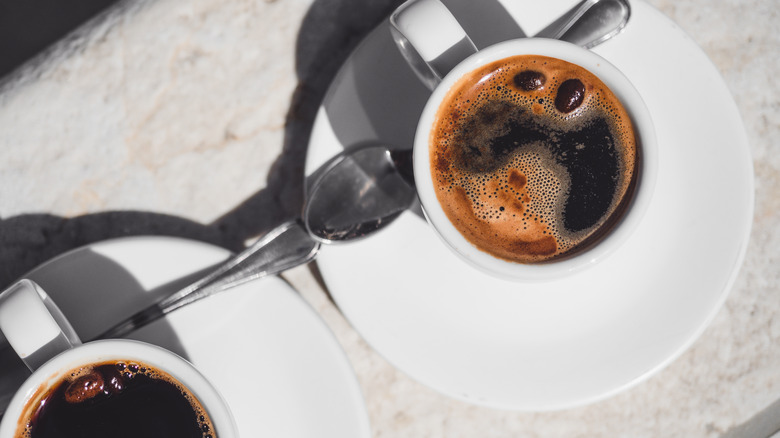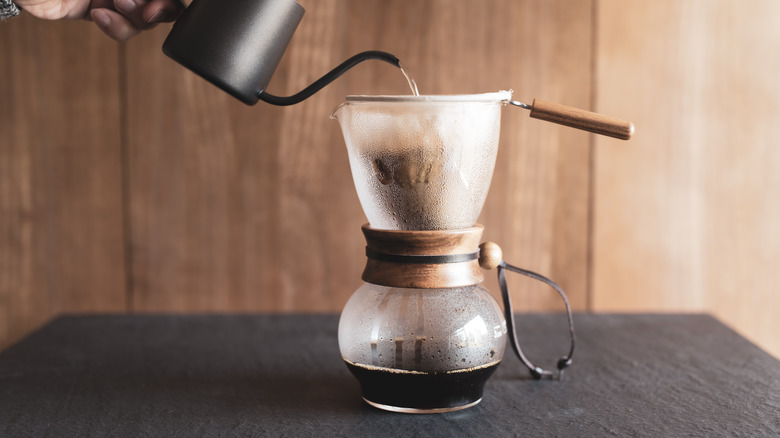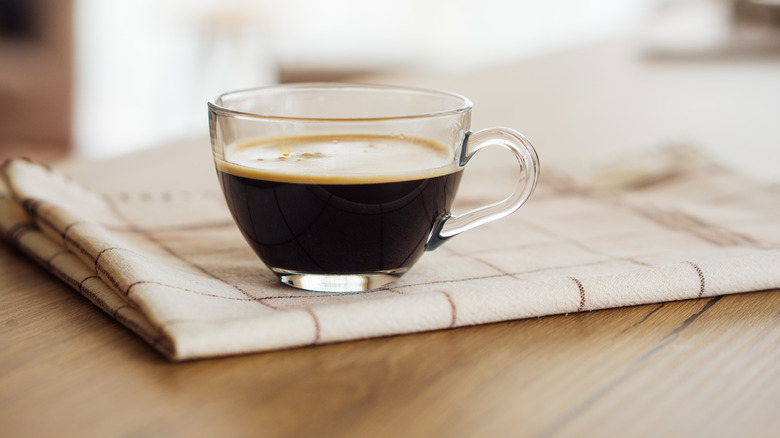Americano Vs. Drip Coffee: What's The Difference?
If you place a mug filled with an americano next to freshly brewed drip coffee, you'll hardly be able to tell any difference by just looking at the two. Both are black coffees similar in color and consistency, and they are both made from just two ingredients: coffee beans and water. But that is where the similarities end between the two.
The biggest difference between an americano and drip coffee is the method to brew each one. Drip coffee is made by pouring hot water over a filter holding ground coffee beans, and done either in electric drip machines or manual pour-over coffee makers. The water slowly extracts flavor from the grounds and passes the brew through the filter with the help of gravity, gradually dripping into a vessel placed below. However, a drip coffee doesn't always have to be brewed hot; there are also cold versions made by pouring chilled water over the beans.
On the flip side, an americano is an espresso-based drink made by adding water to a shot or two of espresso. This shot is pulled from dedicated machines that rapidly extract coffee by using heat and the force of pressurized water. As such, an americano is never brewed cold. An iced version is possible but still requires a hot shot of espresso, which is then chilled with cold water and ice.
Drip coffee has a higher water to bean ratio
Another distinction between an americano and drip coffee is the amount of water needed. Although the ratios aren't set in stone, an americano generally uses two parts of water for every shot of espresso. You could use more or less water depending on your preference, or even double the amount of espresso for a stronger cup.
On the contrary, the golden ratio for brewed drip coffee is 6 ounces of water for every tablespoon or two of ground beans. This means that drip coffees have more water in comparison to americanos, and they typically come in larger serving sizes. Whereas a standard americano is 90 milliliters or 3 ounces, a drip coffee can be twice as much and comes in upwards of 180 milliliters or 6-ounce cups.
There is also a difference in the caffeine content of the two drinks. An americano will only have as much caffeine as the espresso that it is brewed from. According to the USDA, 1 ounce (aka one shot) of espresso has 63 milligrams of caffeine, so that's what an americano will have. However, drip coffee's caffeine content is measured per ounce: Each ounce of the brewed java has between 8.1 to 15mg of caffeine. As a result, its caffeine content will depend on how many ounces of drip coffee you've brewed — for instance, a 6-ounce cup will pack between 49 to 90 milligrams of caffeine.
An americano tastes similar to espresso
Some theories claim that the americano was invented by American soldiers that were stationed in Italy during the Second World War. Dissatisfied by the local espresso, which was too strong for their taste, they began adding water to dilute the robust shot. This gave rise to americano: a diluted espresso that more closely resembled the drip coffee that was popular back at home.
As such, an americano is closer to an espresso in taste, but is watered down just enough to make it more palatable to those who don't quite fancy the robust punch of a dark roast. It still packs the rich and complex flavors that one would expect from an espresso though. In comparison, the slow extraction used to brew drip coffee gives it a deeper flavor profile that's more clean and rounded than an americano's full-bodied intensity. However, the exact flavor will depend on your coffee beans. For instance, French roast beans will impart a noticeably smoky flavor — regardless of whether they are used in French presses, americanos, or drip coffees.
Another difference is that, unlike drip coffee, an americano will have the frothy crema that floats on top of an espresso, giving the drink a rich mouthfeel. In fact, some even invert the process of making an americano by adding the espresso to a cup of water rather than the other way round. This simple change helps the brew retain more of it.



